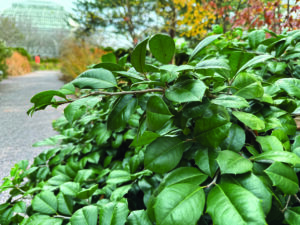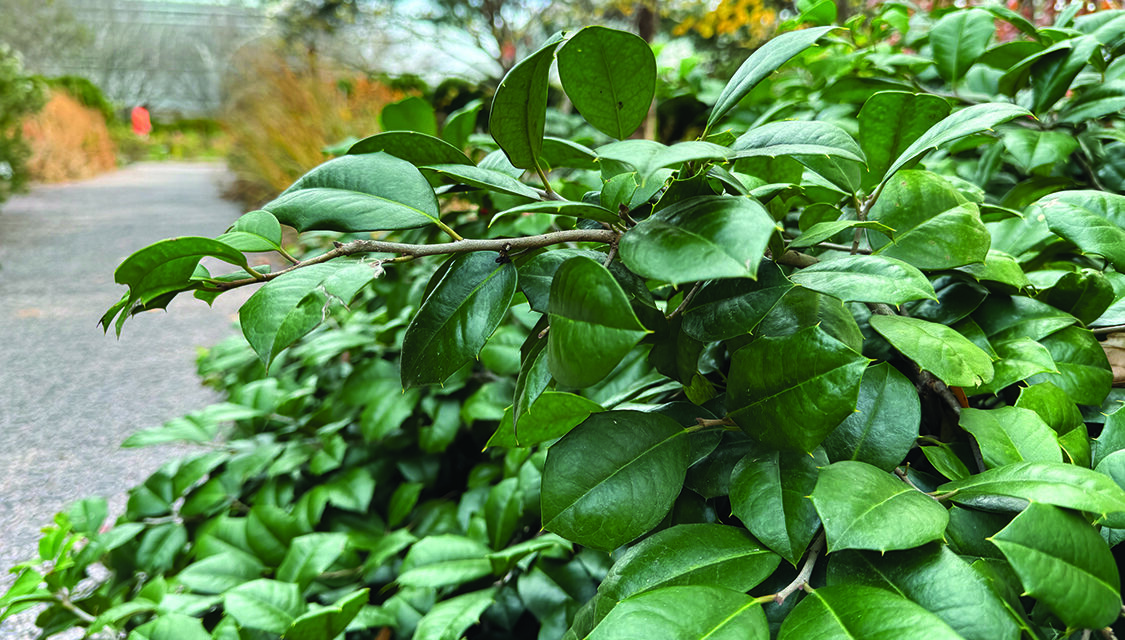
Sometimes characterized as odd or unusual due to its uniquely diminutive mounding properties, the Maryland Dwarf has also been applauded for its versatility growing in a range of landscape conditions, and for adding layered interest to winter garden greenery. (Photo courtesy Devin Dotson, U.S. Botanical Garden)
Each holiday season, a bevy of beloved botanicals take center stage. These include the array of fir, spruce, and pine trees serving as the home’s focal point.
Picturesque Poinsettias fill up tabletops, adding festive pops of color.
But among the most iconic yuletide plants is the Holly, with distinctive dark green pointy leaves punctuated with tiny red drupes (often called ‘berries’, these are actually fleshy fruits encasing a pit).
While there are hundreds of types of woody trees and shrubs included in this Ilex genus, the one most often linked to traditional Christmas celebrations is the English Holly (Ilex aquifolium).
A close second, often substituted for it, is the American Holly (Ilex opaca), which is native to the eastern and south-central United States roughly ranging from coastal Massachusetts to Florida, and also growing as far west as southeastern Missouri and eastern Texas, according to the Lady Bird Johnson Wildflower Center Plant Database.
American Holly can grow as tall as 25 feet., even 60 feet in the warmer parts of its range, the database noted.
As impressive as those towering specimens are, their footprint is far too large for small-to-moderate yards to realistically accommodate. Fortunately, over the years, horticulture and nursery specialists have cultivated more compact Dwarf Holly varieties, notably, the Maryland Dwarf, also called Maryland Spreader.
Sometimes characterized as odd or unusual due to its uniquely diminutive mounding properties, the Maryland Dwarf has also been applauded for its versatility growing in a range of landscape conditions, and for adding layered interest to winter garden greenery.
In 2016, it was honored as Holly of the Year by the Holly Society of America. President Sue Hunter, who also owns Heartwood Nursery near York, Pa., noted that although discovered by Tom Dilatush, and registered in 1942 by Earle Dilatush, it’s only been within the past 15 years that the Maryland Dwarf has “gained the recognition and use that it deserves.”
“This is due to rekindled interest in using native plants,” Hunter noted. “Not every garden or landscape can support the use of a large, female native American Holly. ‘Maryland Dwarf’ is perfect for smaller areas, native and evergreen. The low branching foliage and red ‘berries’ support a desirable habitat for ground-dwelling birds and other small wildlife. It is stunning as a single specimen, or can be planted as a hedge row or border.
“Planted with fall-blooming asters, the effect is especially effective. As an older single specimen, ‘Maryland Dwarf’ can reach a height of 4 feet high by 12 feet wide in 30 years.”
In announcing the cultivar’s 2016 award, the HSA stated: “To this day it remains the best dwarf form of American holly. It rarely grows over three feet tall, even at maturity, but grows horizontally about a foot per year. A typical ten-year old specimen will be about two feet tall and ten feet wide, with dense evergreen, spiny foliage. ‘Maryland Dwarf’ is a female plant, and will produce red fruits, but these are seldom numerous.”
David Kidwell-Slak, assistant manager of Horticulture at United States Botanic Garden, noted that in all his experience, 20 years as a public horticulture professional, he’d never seen another Dwarf Holly which grew so low and in so prostrate a form.
Kidwell-Sark first became aware of the Maryland Dwarf a number of years ago during a professional conference held at Chanticleer Gardens.
“It was so unusual,” he noted, that the next time he saw one, at a plant sale held during another conference, he purchased and planted it.
“Like most American hollies, it prefers either sun or mostly sun, but will tolerate some shade, preferring ground that’s evenly moist, without needing to be too wet. It’s also cold hardy down to -20 degrees. Once you find it a good spot, it usually does very well,” he noted.
Unfortunately, that spot wasn’t in Kidwell-Slak’s home garden. But he was able to successfully transplant it at the small USDA research farm where he was working at the time, and as far as he knows, it’s still doing well.
Dilatush, who first developed the variety, worked at a New Jersey nursery, so it isn’t clear how the name came to include nearby Maryland.
But the 2023 HSA Holly of the year, ‘Sir Landon,’ does have a direct link to the state.
According to a 2011 issue of the Holly Society Journal, “This holly originated as a chance seedling around 1998 at Patuxent Valley Nurseries in Highland, Md, where it was discovered by proprietor Daniel C. Turner. Impressed with the plant’s especially large, dark green leaves, Mr. Turner selected and named the tree after his grandson, Landon Southard in 2010. This new selection, ‘Sir Landon’, was registered with the Holly Society in 2011.
HSA President Hunter had nothing but high praise for the Maryland native.
“In my experience as a propagator of Ilex, ‘Sir Landon’ is one of the best male native Hollies to be introduced. It is easy to grow with little effort, develops a nice, central leader, and makes a perfect focal point for a larger garden or broader landscape.
It is a male Holly, so it develops dense clusters of fragrant pollen-bearing male flowers that support native bees and other beneficial pollinators. ‘Sir Landon’ lends itself well as a handsome, green backdrop for early spring flowering deciduous natives such as Serviceberry, Redbud, and Fringetree.”
For more information, visit https://www.hollysocam.org.






